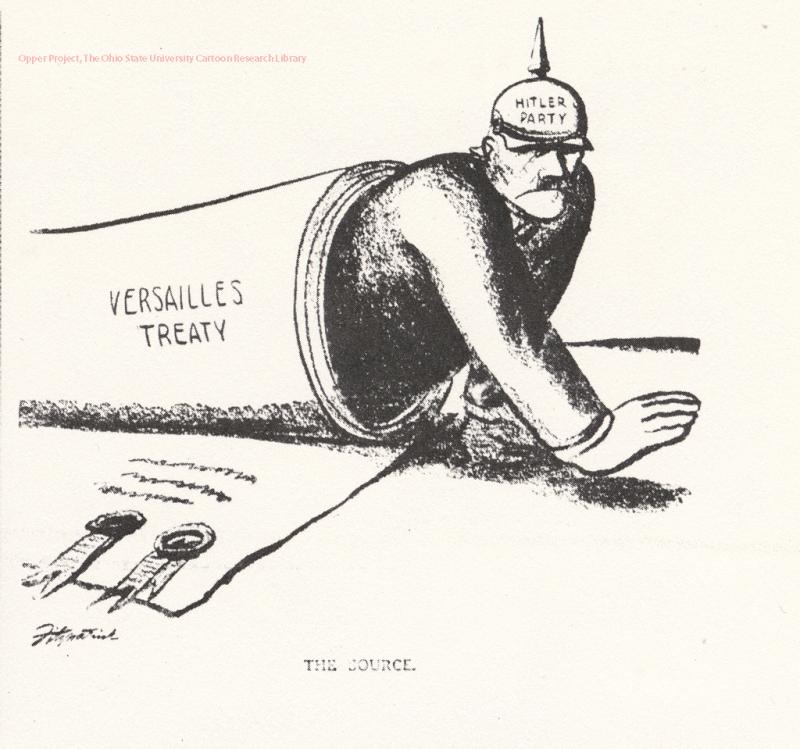After five years of devastating conflict between the Central and Allied powers, World War I came to an end with the Treaty of Versailles. The peace treaty required Germany to disassemble its military, pay war reparations, and give up its colonies overseas. [1] Although this treaty marked the end of this war, the United States never officially signed the Treaty of Versailles. This led to their decision to also not participate in the League of Nations, which was an “Organization of Nations formed in the aftermath of the Great War to Mediate disputes and maintain international peace”. [2] During this period, President Wilson was adamant about signing the Treaty and joining the League of Nations but faced opposition in Congress. One of the main reasons for opposition was because of reservationists. Reservationists were those who wanted to limit the participation of Americans in the League of Nations.[3] There were many isolationists who wanted to stay away from foreign conflict, and that led to the U.S. not signing the Treaty or joining the League of Nations.[4] The final votes in the Senate were 39 in favor of the treaty, and 55 against. [5]
The decision for the United States to sign the treaty was one of the most anticipated events during this time, and many factors played into the end results. One of these factors being the mental and physical health of President Wilson. During the pinnacle of the discussion surrounding the treaty, Wilson suffered a stroke and was left mentally and physically handicapped.[6] Many scientists, psychologists, and historians have studied the correlation between Wilson’s health and the rejection of The Treaty of Versailles. American historian Thomas A. Bailey summarized that the treaty would not have been defeated if Wilson was healthy.[7] Bailey believed that Wilson would have been able to successfully convince his opposers, such as Henry Cabot Lodge, to sign the treaty if he was healthy.[8] Henry Cabot Lodge, one of the republican senators, heavily opposed the ratification of the treaty because of his isolationist views. He believed that the U.S. did not have any obligation to interfere with foreign conflict.[9] He was mainly against Article X of the treaty which required United States to give support to any member of the League of Nation when external aggression occurs.[10] All of these events led to the U.S. not ratifying the treaty, which gave the Germans in desperation the opportunity to seek revenge.
This historical source was created by Daniel Fitzpatrick and was published on October 19th, 1930. This picture consists of an individual with a “Hitler Party” hat wrapped around The Treaty of Versailles. This picture symbolizes many different interpretations regarding the Treaty of Versailles, League of Nations, and foreshadowing of conflict. When the Versailles Treaty was put into effect, Germany was put in a position of desperation. The individual who is wrapped in the Treaty symbolizes the desperation and suffering that the Germans had to consequently face. They were required to dismantle their military and was responsible for a lot of reparations for the war. The amount of burden that was put on Germany gave rise to people like Adolf Hitler, who wanted to get out of this predicament and seek revenge.[11] When a person or group is in a state of desperation, this leads to dangerous scenarios, since that party has nothing to lose. Many people believe that United States not partaking in the Treaty or League of Nation led to the rise of World War II. If the League of Nations had the security of the United States military, the events unfolding to World War II may have been drastically different. This piece was published in 1930, which was many years after the war ended. The author of this piece may have used hindsight bias to show the mistakes of putting Germany in this position of despair, since Hitler rose to prominence around 1930.[12] This piece shows that the Nazi party rose because of the Versailles Treaty and the League of Nations, which may have ended differently if the United States accepted the treaty. This can be seen by the hat worn by the person in this picture labelled “Hitler Party”.
[1] David Emory Shi, America: A Narrative History (Brief Twelfth Edition) (W. W. Nortan & Company 2021), 928.
[2] Ibid., 928.
[3] Ibid., 916.
[4] Ibid., 918
[5] Ibid., 920
[6] Lloyd E. Ambrosius, “Woodrow Wilson’s Health and the Treaty Fight, 1919-1920” The International History Review, No. 1 (1987): 73.
[7] Ibid., 74.
[8] Ibid.
[9] John Pyne, Gloria Sesso, “Woodrow Wilson and the U.s. Ratification of the Treaty of Versailles” OAH Magazine of History, No. 3 (1995): 64.
[10] U.S. History, Pre-Columbian to the New Millenium,
https://www.ushistory.org/us/45d.asp , accessed November 13, 2022
[11] Ibid., 914
[12] History Extra, Your Guide to Adolf Hitler: Key Facts About the Nazi Dictator,
https://www.historyextra.com/period/second-world-war/adolf-hitler-fuhrer-facts-guide-rise-nazi-dictator-biography-pictures/ , accessed November 13, 2022
